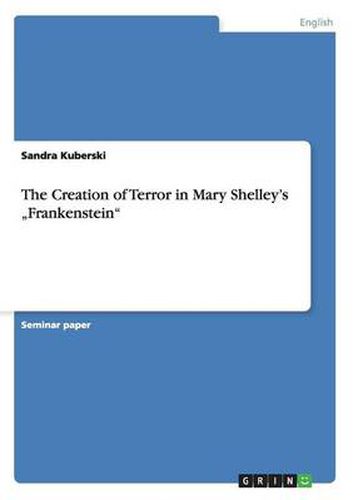Readings Newsletter
Become a Readings Member to make your shopping experience even easier.
Sign in or sign up for free!
You’re not far away from qualifying for FREE standard shipping within Australia
You’ve qualified for FREE standard shipping within Australia
The cart is loading…






Seminar paper from the year 2011 in the subject English Language and Literature Studies - Culture and Applied Geography, grade: 1,3, University of Constance, course: British Literature & Culture, language: English, abstract: During the last two centuries, Frankenstein gained the reputation of a modern myth. Every generation gets to know Frankenstein within a new historical and social context. So it has to be said that the reception of Shelley’s masterpiece changed over the years. The creature of Victor Frankenstein became the archetype of a monster, a model for many specters that followed. Mary Shelley was born on 30 August 1797 and died on 1 February 1851 at the age of 53. She was the daughter of the philosopher William Godwin and his wife Mary Wollstonecraft, who was known as a philosopher and feminist. Both her parents had talents in writing and this talent should be inherited to their daughter as well. In 1816 she married her lover, the famous poet Percy Bysshe Shelley. In the summer of 1816 the famous couple went on a journey to Switzerland, accompanied by Mary’s stepsister Claire, who arranged for them a meeting with her lover Lord Byron. During their stay at the Villa Diodati in Geneva the group talked about science and inspired by some German ghost tales decided to have a ghost-story contest, which led to the initial draft of Frankenstein. Mary Shelley’s tale is the only one of those stories which has been completed. The first edition of Frankenstein was released in 1818, another one in 1831, changed and corrected by Mary Shelley herself. The romantic period was among other things also the time of an enormous paradigm shift in science. The Frankenstein novel has this shift as a basis and combines scientific horror with elements of traditional Gothic fiction. The turn of the century also brought a growing interest in landscape and nature. In 1757 the Irish philosopher Edmund Burke released A Philosophical Enquiry into the Origin of Our Ideas of the Sub
$9.00 standard shipping within Australia
FREE standard shipping within Australia for orders over $100.00
Express & International shipping calculated at checkout
Seminar paper from the year 2011 in the subject English Language and Literature Studies - Culture and Applied Geography, grade: 1,3, University of Constance, course: British Literature & Culture, language: English, abstract: During the last two centuries, Frankenstein gained the reputation of a modern myth. Every generation gets to know Frankenstein within a new historical and social context. So it has to be said that the reception of Shelley’s masterpiece changed over the years. The creature of Victor Frankenstein became the archetype of a monster, a model for many specters that followed. Mary Shelley was born on 30 August 1797 and died on 1 February 1851 at the age of 53. She was the daughter of the philosopher William Godwin and his wife Mary Wollstonecraft, who was known as a philosopher and feminist. Both her parents had talents in writing and this talent should be inherited to their daughter as well. In 1816 she married her lover, the famous poet Percy Bysshe Shelley. In the summer of 1816 the famous couple went on a journey to Switzerland, accompanied by Mary’s stepsister Claire, who arranged for them a meeting with her lover Lord Byron. During their stay at the Villa Diodati in Geneva the group talked about science and inspired by some German ghost tales decided to have a ghost-story contest, which led to the initial draft of Frankenstein. Mary Shelley’s tale is the only one of those stories which has been completed. The first edition of Frankenstein was released in 1818, another one in 1831, changed and corrected by Mary Shelley herself. The romantic period was among other things also the time of an enormous paradigm shift in science. The Frankenstein novel has this shift as a basis and combines scientific horror with elements of traditional Gothic fiction. The turn of the century also brought a growing interest in landscape and nature. In 1757 the Irish philosopher Edmund Burke released A Philosophical Enquiry into the Origin of Our Ideas of the Sub